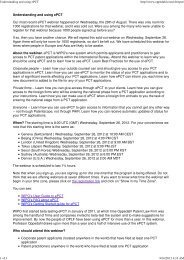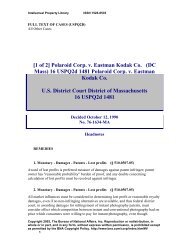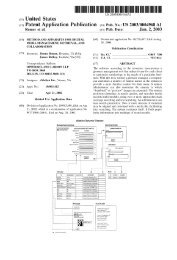sro<strong>be</strong>rts on DSK5SPTVN1PROD with RULES48782 Federal Register / Vol. 77, No. 157 / Tuesday, August 14, 2012 / Rules and Regulations1.154(a)(6), 1.162, and 1.163(b)(6),1.175, 1.492(h), and 1.495(c)(1)(ii), is forconsistency with the use of the phrase‘‘the inventor’s oath or declaration’’ todenote: (1) the oath or declaration under35 U.S.C. 115(a), substitute statementunder 35 U.S.C. 115(d), or assignmentstatementunder 35 U.S.C. 115(e)executed by or with respect to theinventor for an application naming onlyone inventor; and (2) the oaths ordeclarations under 35 U.S.C. 115(a),substitute statements under 35 U.S.C.115(d), or assignment-statements under35 U.S.C. 115(e) that collectively have<strong>be</strong>en executed by or with respect to allof the joint inventors for an applicationnaming joint inventors.Section 1.17: Section 1.17(g) isamended to refer to the filing of anapplication on <strong>be</strong>half of an inventor bya person who otherwise showssufficient proprietary interest in thematter under § 1.46, rather than thefiling of an application by other than allthe inventors or by a person not theinventor under former § 1.47. Thischange is for consistency with thechanges to applicant practice in §§ 1.42,1.43, 1.45, and 1.46. Thus, an assigneeor obligated assignee will no longer <strong>be</strong>required to file a petition and fee to <strong>be</strong>considered the applicant or to execute asubstitute statement (in lieu of an oathor declaration) with respect to anonsigning inventor.Section 1.17(i) is amended to refer tosupplying the name or names of theinventor or inventors in an applicationwithout either an application data sheetor an inventor’s oath or declaration(rather than just without an oath ordeclaration as prescri<strong>be</strong>d by § 1.63).This change is for consistency with thechanges to practice for naming theinventors in § 1.41.Section 1.27: Section 1.27(c)(2) isamended to indicate that a writtenassertion of small entity status can <strong>be</strong>signed by: (1) The applicant (§ 1.42 or§ 1.421); (2) a patent practitioner ofrecord or a practitioner acting in arepresentative capacity under § 1.34; (3)the inventor or a joint inventor, if theinventor is the applicant; or (4) theassignee. This change is for consistencywith the change in practice concerningwho is the applicant for patent in § 1.42.This change also results in any writtenassertion <strong>be</strong>ing signed by or on <strong>be</strong>half ofthe real party in interest, rather than bya party who no longer has a financialinterest in the application.Section 1.31: Section 1.31 is amendedto provide that an applicant for patentmay file and prosecute the applicant’sown case, or the applicant may givepower of attorney so as to <strong>be</strong>represented by one or more patentpractitioners or joint inventors, exceptthat a juristic entity (e.g., organizationalassignee) must <strong>be</strong> represented by apatent practitioner even if the juristicentity is the applicant. This change isfor consistency with the change inpractice concerning who is theapplicant for patent in § 1.42. Thus, allpapers submitted on <strong>be</strong>half of a juristicentity must <strong>be</strong> signed by a patentpractitioner unless otherwise specified,§ 1.33(b)(3). Juristic entities includecorporations (MPEP § 409.03(b)) or othernon-human entities created by law andgiven certain legal rights. This change is<strong>be</strong>cause juristic entities have <strong>be</strong>enattempting to prosecute patentapplications <strong>be</strong>fore the Office pro se andrequesting additional assistance fromexaminers. Juristic entities attempting toprosecute patent applications <strong>be</strong>fore theOffice pro se also make more proceduralerrors that result in delays inprosecution. Accordingly, this changewill facilitate a reduction in the Office’sbacklog and pendency by reducingprosecution delays caused byprocedural errors.Section 1.31 also provides that theOffice cannot aid in the selection of apatent practitioner.Section 1.32: Section 1.32(a)(2) isamended to provide that the term‘‘power of attorney’’ means a writtendocument by which a principalauthorizes one or more patentpractitioners or joint inventors to act onthe principal’s <strong>be</strong>half. Section 1.32(a)(3)is amended to provide that the term‘‘principal’’ means the applicant (§ 1.42)for an application for patent and thepatent owner for a patent, including apatent in a supplemental examination orreexamination proceeding, and that theprincipal executes a power of attorneydesignating one or more patentpractitioners or joint inventors to act onthe principal’s <strong>be</strong>half. Section 1.32(a)(4)is amended to provide that the term‘‘revocation’’ means the cancellation bythe principal of the authority previouslygiven to a patent practitioner or jointinventor to act on the principal’s <strong>be</strong>half.Section 1.32(a)(6) is added to providethat the term ‘‘patent practitioner ofrecord’’ means a patent practitioner whohas <strong>be</strong>en granted a power of attorney inan application, patent, or otherproceeding in compliance with§ 1.32(b), and that the terms‘‘practitioner of record’’ and ‘‘attorneyor agent of record’’ also mean a patentpractitioner who has <strong>be</strong>en granted apower of attorney in an application,patent, or other proceeding incompliance with § 1.32(b). Thesechanges are for consistency with thechange in practice concerning theapplicant for patent in § 1.42.VerDate Mar2010 17:28 Aug 13, 2012 Jkt 226001 PO 00000 Frm 00008 Fmt 4701 Sfmt 4700 E:\FR\FM\14AUR6.SGM 14AUR6Section 1.32(b) is amended to providethat a power of attorney must: (1) Be inwriting; (2) name one or morerepresentatives in compliance with§ 1.32(c); (3) give the representativepower to act on <strong>be</strong>half of the principal;and (4) <strong>be</strong> signed by the applicant forpatent (§ 1.42) or the patent owner. Thisprovision also applies in reissueapplications, supplemental examinationproceedings, and reexaminationproceedings. These changes are forconsistency with the change in practiceconcerning who is the applicant forpatent in § 1.42.Section 1.32(b)(4) provides that apatent owner who was not the applicantunder § 1.46 must appoint any power ofattorney in compliance with §§ 3.71 and3.73. This covers a patent owner in areissue application who was not theapplicant under § 1.46 in theapplication for the original patent, aswell as a patent owner in asupplemental examination orreexamination proceeding who was notthe applicant under § 1.46.Section 1.32(d) is added to providethat a power of attorney from a priornational application for which <strong>be</strong>nefit isclaimed under 35 U.S.C. 120, 121, or365(c) in a continuing application mayhave effect in the continuing applicationif a copy of the power of attorney fromthe prior application is filed in thecontinuing application unless: (1) Thepower of attorney was granted by theinventor; and (2) the continuingapplication names an inventor who wasnot named as an inventor in the priorapplication. Former § 1.63(d)(4)provided that, when filing continuationand divisional applications andincluding a copy of a declaration fromthe parent application, applicantsshould ‘‘identify’’ in the continuation ordivisional any change in power ofattorney that occurred after the filing ofthe parent application. The requirementin former § 1.63(d)(4) to ‘‘identify’’ thechange in power of attorney has <strong>be</strong>eninterpreted differently by applicants,with varying success of the Officerecognizing the change in power ofattorney. Attempts to comply haveincluded: filing a copy of the power ofattorney from the parent, filing a copyof only the notice of acceptance ofpower of attorney, and making astatement about the power of attorney ina transmittal letter that accompanied thecontinuation or divisional application.Sometimes applicants did notaccurately identify the change in powerof attorney (e.g., the power of attorneydocument in the parent applicationappointed specific practitioners byname and registration num<strong>be</strong>r, but thepapers filed in the continuation or
Federal Register / Vol. 77, No. 157 / Tuesday, August 14, 2012 / Rules and Regulations48783sro<strong>be</strong>rts on DSK5SPTVN1PROD with RULESdivisional application directed theOffice to recognize the practitionersassociated with a customer num<strong>be</strong>r ashaving power of attorney). Specificallyrequiring a copy of the power ofattorney in the continuing applicationin all situations (even where a change inpower did not occur in the priorapplication) will make the record clearwith respect to who has power ofattorney.The Office does not recommend thatpractitioners use a combineddeclaration and power of attorneydocument, and no longer provides acombined declaration and power ofattorney form on its Internet Web site.The power of attorney should <strong>be</strong> fromthe assignee where one exists.Otherwise, the assignee may <strong>be</strong> payingthe bill, while the inventor is providingthe power of attorney, thereby possiblyraising an issue as to who is thepractitioner’s client. Additionally,relationships <strong>be</strong>tween an assignee andthe inventors may deteriorate. It is notuncommon in these situations forinventors to stop cooperating and insome cases file powers of attorney in anattempt to control prosecution of theapplication.Section 1.32(e) is added to providethat if the power of attorney was grantedby the originally named inventive entityand an added inventor pursuant to§ 1.48 does not provide a power ofattorney consistent with the power ofattorney granted by the originallynamed inventive entity, the addition ofthe inventor results in the loss of thatpower of attorney upon grant of the§ 1.48 request. This provision does notpreclude a practitioner from actingpursuant to § 1.34, if applicable.Section 1.33: Section 1.33(a) isamended to specify that if an applicantprovides more than one correspondenceaddress (in a single paper or in differentpapers), the Office will select one of thespecified addresses for use as thecorrespondence address and, if given,may select the correspondence addressassociated with a Customer Num<strong>be</strong>rover a typed correspondence address.This change pertains to the problem thatarises when applicants provide multiplecorrespondence addresses in a singlepaper (e.g., providing both a typedcorrespondence address and a CustomerNum<strong>be</strong>r in a single paper) or multiplepapers (e.g., an oath or declaration, atransmittal letter, and a preliminaryamendment that each includes adifferent correspondence address), andthe Office inadvertently does not selectthe correspondence address actuallydesired by applicant. The Office maythen need to re-mail papers to thedesired address. This change does notaffect the hierarchy provided in§ 1.76(d) for inconsistencies <strong>be</strong>tween anapplication data sheet and otherdocuments. This change is designed toencourage applicants to review theirsubmissions carefully to ensure that theOffice receives clear instructionsregarding the correspondence address.Section 1.33(a) also provides that thecorrespondence address may <strong>be</strong>changed by the parties set forth in§ 1.33(b)(1) (a patent practitioner ofrecord) or § 1.33(b)(3) (the applicantunder § 1.42)). Section 1.33(a) alsoprovides that prior to the appointmentof any power of attorney under § 1.32(b),the correspondence address may also <strong>be</strong>changed by any patent practitionernamed in the application transmittalpapers who acts in a representativecapacity under the provisions of § 1.34.Section 1.33(a) no longer discusses thefiling of an oath or declaration under§ 1.63 as the Office is revising the rulesto allow applicants to postpone filingthe inventor’s oath or declaration untilthe application is otherwise incondition for allowance.Sections 1.33(b)(1) and (2) areamended to provide that amendmentsand other papers, except for writtenassertions pursuant to § 1.27(c)(2)(iii) or(c)(2)(iv), filed in the application must<strong>be</strong> signed by: (1) A patent practitionerof record; (2) a patent practitioner not ofrecord who acts in a representativecapacity under the provisions of § 1.34;or (3) the applicant (§ 1.42). Section1.33(b)(3) also provides that unlessotherwise specified (e.g., terminaldisclaimers and § 3.73(c) statements), allpapers submitted on <strong>be</strong>half of a juristicentity must <strong>be</strong> signed by a patentpractitioner, as § 1.31 provides that ajuristic entity may prosecute a patentapplication only through a patentpractitioner.Section 1.33(f) is added to replaceformer § 1.63(d)(4) with respect to thecorrespondence address. Whereapplication papers (e.g., the inventor’soath or declaration) from a priorapplication are used in a continuingapplication and the correspondenceaddress was changed during theprosecution of the prior application, anapplication data sheet or separate paperidentifying the correspondence addressto <strong>be</strong> used for the continuingapplication must <strong>be</strong> submitted.Otherwise, the Office may not recognizethe change of correspondence addresseffected during the prosecution of theprior application. Historically, someapplicants would file continuingapplications with copies of papers fromthe prior application that includecorrespondence addresses to former lawfirms or correspondence addresses thatVerDate Mar2010 17:28 Aug 13, 2012 Jkt 226001 PO 00000 Frm 00009 Fmt 4701 Sfmt 4700 E:\FR\FM\14AUR6.SGM 14AUR6are no longer current. This change willfacilitate the processing of patentapplications by the Office by making iteasier to determine the correctcorrespondence address and reduce thenum<strong>be</strong>r of instances where the Officemails correspondence to an incorrectaddress.Section 1.33(g) is added to providethat a practitioner acting in arepresentative capacity whosecorrespondence address is thecorrespondence address of record in anapplication may change thecorrespondence address after the patenthas issued, provided that the change ofcorrespondence address is accompaniedby a statement that notice has <strong>be</strong>engiven to the patentee or owner. Section1.33(g) provides a means forpractitioners acting in a representativecapacity in an application to effect achange in correspondence address afterthe patent has granted but would notprovide authority to a practitioneracting under § 1.34 to change thecorrespondence address in anapplication. See § 1.33(a).Practitioners that file and prosecutean application in a representativecapacity, pursuant to § 1.34, usuallyprovide their business address as thecorrespondence address of record. Oncethe patent issues, practitioners haveattempted to withdraw as attorney oragent by filing a petition, and alsoattempt to change the correspondenceaddress to direct correspondence to thepatentee’s or owner’s address. Suchattempts have not <strong>be</strong>en successful as therules did not permit the correspondenceaddress to <strong>be</strong> changed by a practitioneracting in a representative capacity, norwould the Office grant withdrawalwhere a practitioner is not of record. SeeChange in Procedure for Requests toWithdraw from Representation In aPatent Application, 1329 Off. Gaz. Pat.Office 99 (Apr. 8, 2008). There have<strong>be</strong>en instances where practitionersacting in a representative capacity haveindicated that they have repeatedlyrequested that the client change thecorrespondence address, but the clienthas refused to submit the change ofcorrespondence address to the Office.Section 1.33(g) will permit practitionersto change the correspondence addressafter a patent has issued wherepractitioners have provided notice tothe patentees or owners.Section 1.36: Section 1.36(a) isamended to change ‘‘by an applicant forpatent (§ 1.41(b)) or an assignee of theentire interest of the applicant, or theowner of the entire interest of a patent’’to ‘‘by the applicant or patent owner.’’An assignee conducting prosecution ofa national patent application does so as
- Page 1:
UNIFORM CERTIFICATE OF ATTENDANCE F
- Page 4 and 5:
SPTO explains the America Invents A
- Page 6 and 7:
PTO/SB/01A (01-09)Approved for use
- Page 8 and 9: PTO/SB/ (06-12)Approved for use thr
- Page 10 and 11: PTO/ (06-12)Approved for use throug
- Page 12 and 13: PTO/(06-1Approved for use through 0
- Page 14 and 15: What will change about the oath ord
- Page 16 and 17: Action item●●●If you have not
- Page 18 and 19: But 37 CFR § 1.63 says:A person ma
- Page 20 and 21: ●●●Combined assignment anddec
- Page 22 and 23: ●●●●●●Consequences of i
- Page 24 and 25: How to file the ADSs●●If you pr
- Page 26 and 27: Supplemental ADSAny ADS filed after
- Page 28 and 29: Provisionals●●●Rules are a bi
- Page 30 and 31: Are all assignees applicants?●●
- Page 32 and 33: Substitute Statement●●●This f
- Page 34 and 35: ●●●Docket consequences of the
- Page 36 and 37: New Rule-46 practice67●●●Rule
- Page 38 and 39: Consequences of AIA for PCT filers
- Page 40 and 41: If you are entrusted the US nationa
- Page 42 and 43: ●●●Choosing between a “bypa
- Page 44 and 45: ●●●Getting your name and addr
- Page 46 and 47: Exercises relating to September 16,
- Page 48 and 49: Important AIA webinar September 6
- Page 50 and 51: Exercises relating to September 16,
- Page 52 and 53: 48776 Federal Register / Vol. 77, N
- Page 54 and 55: sroberts on DSK5SPTVN1PROD with RUL
- Page 56 and 57: sroberts on DSK5SPTVN1PROD with RUL
- Page 60 and 61: sroberts on DSK5SPTVN1PROD with RUL
- Page 62 and 63: sroberts on DSK5SPTVN1PROD with RUL
- Page 64 and 65: sroberts on DSK5SPTVN1PROD with RUL
- Page 66 and 67: sroberts on DSK5SPTVN1PROD with RUL
- Page 68 and 69: sroberts on DSK5SPTVN1PROD with RUL
- Page 70 and 71: sroberts on DSK5SPTVN1PROD with RUL
- Page 72 and 73: sroberts on DSK5SPTVN1PROD with RUL
- Page 74 and 75: 48798 Federal Register / Vol. 77, N
- Page 76 and 77: 48800 Federal Register / Vol. 77, N
- Page 78 and 79: 48802 Federal Register / Vol. 77, N
- Page 80 and 81: 48804 Federal Register / Vol. 77, N
- Page 82 and 83: 48806 Federal Register / Vol. 77, N
- Page 84 and 85: 48808 Federal Register / Vol. 77, N
- Page 86 and 87: 48810 Federal Register / Vol. 77, N
- Page 88 and 89: 48812 Federal Register / Vol. 77, N
- Page 90 and 91: 48814 Federal Register / Vol. 77, N
- Page 92 and 93: 48816 Federal Register / Vol. 77, N
- Page 94 and 95: sroberts on DSK5SPTVN1PROD with RUL
- Page 96 and 97: sroberts on DSK5SPTVN1PROD with RUL
- Page 98 and 99: 48822 Federal Register / Vol. 77, N
- Page 100 and 101: sroberts on DSK5SPTVN1PROD with RUL
- Page 102: 48826 Federal Register / Vol. 77, N





